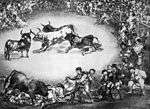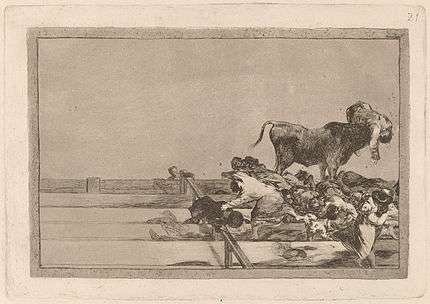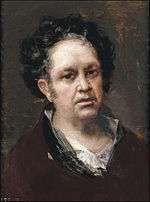La Tauromaquia
.jpg)

La Tauromaquia (Bullfighting) is a series of 33 prints created by the Spanish painter and printmaker Francisco Goya, which was published in 1816. The works of the series depict bullfighting scenes.
Background

Goya created Tauromaquia between 1815 and 1816, at the age of 69, during a break from his famous series The Disasters of War. The Disasters of War and the Caprichos, the series he had created previously, served as visual criticism on subjects concerning war, superstition, and contemporary Spanish society generally, including anticlerical scenes. Because of their sensitive subjects, few people had seen these works during Goya's lifetime.
Bullfighting was not politically sensitive, and the series was published at the end of 1816 in an edition of 320—for sale individually or in sets—without incident. It did not meet with critical or commercial success.[1] Goya was always charmed by bullfighting, a theme that obviously inspired him, since it was the subject of many of his works: in a self-portrait (c 1790-95) he depicted himself in a bullfighter's suit; in 1793 he completed a series of eight paintings on tinplate, created for the Royal Academy of Fine Arts of San Fernando, which depicted scenes from bulls' lives from the moment of their birth to the time they enter the bullring; in 1825 he made the series Los toros de Burdeos (The Bulls of Bordeaux) (1825), which Delacroix purchased a copy of.[2] Indicative of his love for bulls is the fact that he signed one of his letters as Francisco de los Toros (Francisco of the Bulls).[3][4]
The works
Goya used mainly the techniques of etching and aquatint in this series. The artist focuses on the violent scenes that take place in the bullring and the daring movements of the bullfighters. The events are not presented as they are viewed by a viewer in the stands, but in a more direct way, in contrast with The Bulls of Bordeaux where the events are presented as a means of popular entertainment.[5]
The works of the series
-

Νο. 1: Modo con que los antiguos Espanoles cazaban los toros a caballo en el campo
-
.jpg)
Νο. 2: Otro modo de cazar a pie
-

Νο. 3: Los moros establecidos en España, prescindiendo de las supersticiones de su Alcorán, adoptaron esta caza y arte, y lancean un toro en el campo.
-
.jpg)
Νο. 4: Capean otro encerrado
-

Νο. 5: El animoso moro Gazul es el primero que lanceo toros en regla
-

Νο. 6: Los Moros hacen otro capeo en plaza con su albornoz
-
.jpg)
Νο. 7: Origen de los arpones o banderillas
-
.jpg)
Νο. 8: Cogida de un moro estando en la plaza
-

Νο. 9: Un caballero espanol mata un toro despues de haber perdido el caballo
-
.jpg)
Νο. 10: Carlos V. lanceando un toro en la plaza de Valladolid
-
.jpg)
Νο. 11: El Cid Campeador lanceando otro toro
-

Νο. 12: Desjarrete de la canalla con lanzas, medias-lunas, banderillas y otras armas
-

Νο. 13: Un caballero espanol en plaza quebrando rejoncillos sin auxilio de los chulos
-

Νο. 14: El diestrisimo estudiante de Falces, embozadoburla al toro con sus quiebros
-

Νο. 15: El famoso Martincho poniendo banderillas al quiebro
-
.jpg)
Νο. 16: El mismo vuelca un toro en la plaza de Madrid
-

Νο. 17: Palenque de los moros hecho con burros para defenderse del toro embolado
-
.jpg)
Νο. 18: Temeridad de martincho en la plaza de Zaragoza
-
.jpg)
Νο. 19: Otra locura suya en la misma plaza
-

Νο. 20: Ligereza y atrevimiento de Juanito Apinani en la de Madrid
-

Νο. 22: Valor varonil de la celebre Pajuelera en la de Zaragoza
-

Νο. 23: Mariano Ceballos, alias el Indio, mata el toro desde su caballo
-

Νο. 24: El mismo Ceballos montado sobre otro toro quiebra rejones en la plaza de Madrid
-
.jpg)
Νο. 25: Echan perros al toro
-
.jpg)
Νο. 26: Caida de un picador de su caballo debajo del toro
-

Νο. 27: El celebre Fernando del Toro, barilarguero, obligando a la fiera con su garrocha
-

Νο. 28: El esforzado Rendon picando un toro, de cuya suerte murio en plaza de Madrid
-
.jpg)
Νο. 29: Pepe Illo haciendo el recorte al toro
-
.jpg)
Νο. 30: Pedro Romero matando a toro parado
-
.jpg)
Νο. 31: Banderillas de fuego
-

Νο. 32: Dos grupos de picadores arrollados de seguida por un solo toro
-

Νο. 33: La desgraciada muerte de Pepe Illo en la plaza de Madrid
References
External links
| |||||||||||||||||||||||||||||||||||||||||||||

